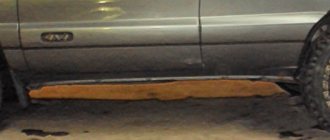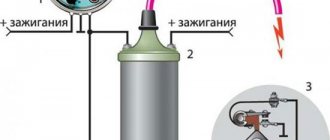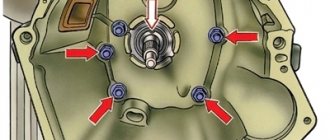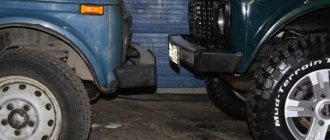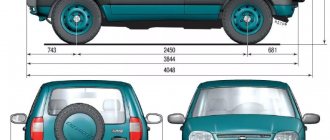The manufacturer installs a 5th manual transmission on the Chevrolet Niva car, which has a 3-shaft design. In particular, there is a drive, secondary and intermediate shaft. The gearbox housing and synchronizer clutches are distinguished by their reliability.
Chevy Niva gearbox
: 1 – input shaft; 2 – clutch release; 3 – front cover with guide sleeve; 4 – input shaft oil seal; 5 – clutch housing; 6 – breather; 7 – gearbox housing; 8 – constant mesh gear of the input shaft; 9 – needle bearing of the secondary shaft; 10 – tray for collecting and draining oil; 11 – synchronizer for 3rd and 4th gears; 12 – third gear gear; 13 – 2nd gear gear; 14 – secondary shaft; 15 – synchronizer of 1st and 2nd gears; 16 – 1st gear gear; 17 – bushing of the 1st gear gear; 18 – intermediate bearing of the secondary shaft; 19 – locking plate of the intermediate bearing; 20 – reverse gear; 21 – nut for fastening the gear selection mechanism; 22 – 5th gear synchronizer; 23 – gear selection mechanism; 24 – fifth gear gear; 25 – support plate fastening bracket; 26 – oil deflector washer; 27 – flange of the elastic coupling of the cardan transmission; 28 – nut; 29 – centering ring seal; 30 – centering ring; 31 – secondary shaft oil seal; 32 – rear bearing of the secondary shaft; 33 – spacer sleeve; 34 – gear block bolt; 35 – gear block bearing; 36 – rear cover of the gearbox; 37 – gear block of 5th gear and reverse gear; 38 – rear bearing of the intermediate shaft; 39 – gear 1st gear of the intermediate shaft; 40 – drain plug; 41 – gear II of the intermediate shaft; 42 – third gear of the intermediate shaft; 43 – lower cover of the gearbox; 44 – intermediate shaft; 45 – constant mesh gear of the intermediate shaft; 46 – front bearing of the intermediate shaft; 47 – clamping washer of the intermediate shaft bearing; 48 – bolt of the clamping washer; 49 – rear bearing of the input shaft.
Chevrolet Niva gear shift control drive
: 1 – support plate fastening nut; 2 – gearbox control drive rod; 3 – hatch cover gasket; 4 – gear shift lever hatch cover; 5 – gear shift lever handle; 6 – gear shift lever; 7 – gear shift lever cover; 8 – sealing cover; 9 – screw for securing the hatch cover; 10 – rear support; 11 – gear shift lever housing; 12 – lower housing of the gear shift lever; 13 – nuts for fastening the rear support; 14 – rear support washer; 15 – nut; 16 – spacer ring; 17 – retaining ring; 18 – ball joint housing; 19 – gear shift lever spring; 20 – ball joint slider; 21 – nuts securing the ball joint housing; 22 – protective cover; 23 – rod end; 24 – support plate; 25 – gearbox.
Chevrolet Niva input shaft diagram
: 1 - retaining ring; 2 - spring washer; 3 - bearing; 4 - input shaft; 5 — synchronizer spring; 6 — synchronizer blocking ring; 7 - retaining ring; 8 - bearing.
Chevrolet Niva secondary shaft diagram
: 1 - retaining ring; 2 - spring washer; 3 — synchronizer hub; 4 — synchronizer clutch; 5 — blocking ring; 6 — synchronizer spring; 7 — washer; 8 — gear III gear; 9 — secondary shaft; 10 - 2nd gear gear; 11 — 1st gear gear; 12 — gear bushing; 13 - bearing; 14 — reverse gear; 15 — thrust washer; 16 — fifth gear gear; 17 — oil deflector washer; 18 — spacer sleeve; 19 — rear bearing of the secondary shaft; 20 - oil seal; 21 — elastic coupling flange; 22 — lock washer; 23 - nut; 24 - seal; 25 - centering ring.
Details of the gear selection mechanism
: 1 — front traction cover; 2 — rod joint axis; 3 — rod joint housing; 4 — thrust eye bushing; 5 — gearbox control drive rod; 6 — front hinge housing cover; 7 - bolt; 8 — guide bar; 9 — guide bar spring; 10 - guide plate; 11 - sealing ring; 12 — gear selector housing; 13 — gear selector lever; 14 - sealing ring; 15 — retaining ring; 16 — ball joint gasket; 17 — seal mounting flange; 18 — washer; 19 - nut; 20 — washer; 21 - spring; 22 — spherical washer of the ball joint; 23 — ball joint of the gear selector lever; 24 - gasket; 25 — guide plate washer.
Parts of the gear selection mechanism control drive
: 1 — ball joint housing; 2 - spring; 3 — ball joint slider; 4 - retaining ring; 5 — gasket of the ball joint housing; 6 — support plate; 7 — gasket of the lower housing; 8 — lower housing of the gear selector lever; 9 — clamp bolt; 10 — washer; 11 — control drive rod clamp; 12 — protective cover; 13 — rod end; 14 — locking stop screw; 15 — axis of the gear selector lever; 16 — toothed washer; 17 — locking stop; 18 — bushing; 19 — spacer sleeve; 20 — gear selector lever; 21 - bushing; 22 — washer; 23 — lever axis nut; 24 — reverse locking pad; 25 — lining bolt; 26 — washer; 27 — sealing cover; 28 — gear selector housing; 29 — rear support; 30 — spacer ring; 31 — rear support washer; 32 — washer; 33 — rear support nut; 34 — washer; 35 — bolt of the gear selector lever housing; 36 — washer; 37 — nut securing the ball joint housing.
Design and principle of operation
The Chevrolet Niva transmission includes the following components:
- A five-speed manual gearbox allows you to change not only the amount of torque, but also the direction of rotation.
- Split front axle with a gearbox mounted on the power elements of the body.
- Dry single-plate clutch, which, when the pedal is pressed, briefly disconnects the transmission from the engine.
- Solid rear axle, into which the gearbox and differential are integrated. This allows you to increase and distribute torque between the wheels of the same axle.
- The intermediate shaft through which torque is transmitted from the gearbox to the transfer case.
- Transfer case that distributes rotational energy between axles.
- Two cardan shafts transmitting power to the axles (front and rear).
- Constant velocity joints that drive the steering wheels.
It works like this: engine torque is transmitted to the manual transmission through the clutch, then through the intermediate shaft to the transfer case and a pair of drive axles.
Help: the transmission of SUVs often includes a winch drive. To do this, a power take-off shaft is built into it. However, this option is not provided in the factory configuration of the Chevrolet Niva.
Is the gear selection mechanism from Classic suitable for VAZ 2123?
In the modern world of developed technologies, equipment and a huge number of spare parts offered by stores, garage buyers and tuning enthusiasts have access to any actions to repair, constructively alter and modernize their cars.
The manual transmission for the VAZ-2123 car is based on the classic gearbox for the VAZ-2107 with several differences:
- the designer excluded the installation of restrictor rings at the end of the secondary shaft;
- a modern spacer bushing has been installed to provide the speedometer drive function;
- The idler gear axis is fixed separately on the manual transmission housing.
If you are faced with a breakdown of the factory gearbox on a Shnivy, and buying a new unit is too expensive, then you can choose a good used version of the classic gearbox and make several modifications yourself.
Tips for replacing the gearbox
Initially, it is necessary to dismantle the factory gearbox with all adjacent mechanisms (muffler, cardan shaft and exhaust shaft). Dismantling is carried out with speed 1 turned on. To install a 4-mortar from a classic, you will also need to rearrange the gear shift assembly itself (shift lever and rocker), and the reverse gear release tab (for this you will have to remove the rear cover).
When moving the gear selector from one gearbox to another, we recommend changing the restrictive retaining ring.
You will have to tinker a little with the rear support crossmember of the gearbox to the body because... classic won't do. The hole for the speedometer cable can be plugged with a rubber seal selected to size.
Useful! When replacing the gearbox, it is recommended to replace all seals and gaskets. Also, with the speed release assembly removed, pay attention to the condition of the clutch release bearing. If necessary, it is easier to replace it while everything is disassembled and accessible.
Signs of trouble
The transmission is constantly subjected to high loads while driving, especially off-road. At the same time, the parts, despite the lubrication and the safety margin laid down by the designers, wear out intensively. Therefore, failure of the Chevrolet Niva transmission is not at all uncommon. And the point here is not in the quality of the parts, but in the level of loads and complexity of the mechanism.
Symptoms of malfunction depend on which component is experiencing problems:
- Clutch. In case of breakdowns, jerking occurs when starting to move, slipping under load, or “driving” when trying to stop or change gear. Sometimes the malfunction manifests itself in the form of noise when pressing the clutch pedal or in other conditions.
- Gear box. This unit is more complex, and accordingly, its breakdowns are more varied. They manifest themselves in unclear or difficult gear shifting. Oil leaks, crunching noises and extraneous noises are also possible.
- Cardans and intermediate shaft. Here, malfunctions manifest themselves in the form of knocking during acceleration, squeaking or vibration while driving.
- Main bridge. In the event of a breakdown, the mechanism begins to make noise, knocking noises occur when accelerating and oil leaks.
- Transfer case. Problems make themselves felt in the form of spontaneous shutdown of bridges, noise and knocking. There may also be an oil leak.
- Constant velocity joints. Worn parts begin to crunch and knock while driving. The crunch is especially noticeable when the steering wheel is turned hard.
Reasons for withdrawal
Everyone knows that the gearbox on cars is the most unpretentious product, but only if you handle it correctly. Let's start from the beginning: the Chevrolet Niva is an all-wheel drive SUV, which, from the very design, was prepared for a track with various types of obstacles. In the video, but you can easily do everything yourself to replace the front struts. Overcoming obstacles means loading the car, and many problems arise from the loads and overloads of the vehicle, in particular, parts of the engine, gearbox, clutch, etc. fail.
Thus, the reasons for dismantling the gearbox may be as follows:
- Removal for subsequent replacement of the entire mechanism. But it’s immediately worth noting that a new box is installed only if the old one is completely unusable. But this doesn’t happen often, only on cars with high mileage.
- For carrying out repair and cleaning work. This work may include: replacement of failed components, gaskets, scenes and other products. replacing the timing chain on a 1.2 Skoda Fabia engine. Brief content and do-it-yourself repairs without using special tools my page in. Chevrolet Niva car. Gearbox on a Chevrolet Niva. On the Chevrolet field with your own hands. It all depends on what was disabled.
- When carrying out repair work on other vehicle components, if the gearbox interferes with these activities.
We won’t take a long look at what you already know, but let’s get straight to the process of dismantling the gearbox on a Chevrolet Niva.
Before you begin the process of dismantling the gearbox, you will need to make sure that this activity is necessary. For example, to change the oil in the box or replace the clutch slave cylinder, you do not need to remove it.
Resource of parts and assemblies
The service life of drive parts depends on compliance with maintenance regulations. The operating manual states that the mileage before transmission repair is 200 thousand kilometers. In practice, this does not apply only to CV joints, which often have to be changed even with less mileage. As for the gearbox and transfer case, according to the owners' reviews, they can withstand the required 200 thousand kilometers without any problems.
A sharp reduction in service life is observed only during extreme off-road use of the vehicle. For example, CV joints quickly break when the anthers are damaged.
Maintenance Recommendations
The cause of the malfunction may be the exhaustion of the intended resource, but most often it lies in non-compliance with basic recommendations for operation and maintenance. Routine maintenance includes only timely replacement of transmission lubricant. It needs to be changed every 40 - 45 thousand kilometers.
Repairing a box is an expensive proposition. It often has to be carried out at a service station, so it is necessary to periodically check the oil level in the gearbox and inspect the crankcase for leaks.
Read news about the new Niva
- Chevrolet Niva gearbox diagram video
- Chevrolet Niva gearbox diagram video
- Chevrolet Niva fuse box with description (up to 2009 release)
- The modernized Lada Niva Legend (4x4) 2021 was shown on the Internet
- Lada 4×4 Bronto - sales stopped, new details » Lada.Online - all the most interesting and useful about LADA cars
- Description of the instrument panel Lada 4×4 (VAZ 2121, 2131) » Lada.Online - all the most interesting and useful about LADA cars
- LADA Niva – Operating manual – Official LADA website
- Chevrolet Niva gasoline consumption per 100 km
| Device and design, technical characteristics, maintenance |
How to remove engine and transmission protection?
The standard equipment of the Chevrolet Niva includes protection in the form of a curved steel plate. This part prevents damage to the engine crankcase and the most critical elements of the transmission. Below it is a mudguard that prevents road dirt from entering the engine compartment.
However, the protection prevents maintenance of the gearbox and front axle gearbox. Therefore, to change the oil or repair key transmission elements, the plate must be removed. To do this, you will need 8 and 10 socket wrenches.
Professional repair of gearboxes for VAZ, GAZ, foreign cars on the same day!
WARRANTY for work according to the warranty card!
Gearbox repair from RUB 1,500.
Does not include the cost of spare parts. Guarantee!
Transmission replacement from RUB 3,000
with warranty (Excluding installation)
Sale of gearboxes from 5000 rub.
A gearbox after a major overhaul with a guarantee is always on sale.
Change of oil
Gearbox oil change, engine oil change
Seasonal tire fitting
The service is not available in all services.
Clutch replacement
A discount is provided when replacing a gearbox in all services.
Transmission of Chevrolet Niva and Lada 4x4: what is the difference
The first thing that catches the eye of the average user is that the Lada’s transmission is controlled by two levers, while the Chevrolet Niva has only one, not counting the gearbox control lever. This is due to the fact that Chevrolet’s upshift and downshift ranges, as well as the center differential lock, are implemented using a single-lever design. In addition, the Niva's front axle gearbox is not attached directly to the engine cylinder block, and the transfer case has three mounting points, unlike the Lada, which has two.
Nevertheless, both cars are absolutely identical in transmission design, have one engine for two, but due to the transfer case set back, the Niva’s intermediate shaft is longer than that of the Lada 4x4 by exactly 250 mm. Moreover, both cardan shafts driving the front and rear axles are completely interchangeable.
Step-by-step instructions for removing the manual transmission and gearbox on a Niva Chevrolet
- And so, first of all, we disconnect the negative terminal from the battery.
- Next we will need to disassemble the center console. I will not explain in detail how this is done, if you cannot do this yourself, then it is better for you not to continue working, but to turn to specialized services.
- We remove it and bring it to this form:
- Unscrew the exhaust pipe from the manifold and disconnect the upper oxygen sensor.
- After we have done this, we lift the car on a lift to make it more convenient for us to work. If this is not possible, then you can work from the pit.
- Next, drain the transmission oil from the gearbox and transfer case, as well as from the rear and front gearboxes.
- Here we see our transfer case, it’s all covered in oil.
- Photo of the gearbox, also covered in oil.
- Next comes a very important point: the drain plugs are all magnetized and after we unscrew them, we carefully inspect them for the presence of foreign particles.
- In our case, there are metal particles on the transfer case plug and on the rear gearbox plug. This means that there is something that has fallen apart and we continue to disassemble the car.
- Next, you need to disassemble the following parts: rear cardan, front cardan, unscrew the rubber couplings on the intermediate cardan.
- Now we remove the sensors from the gearbox and transfer case.
- We disconnect the bracket going from the gearbox to the exhaust pipe and the upper front shield going above the exhaust pipe.
- We place the transmission jack under the transfer case and unscrew the supports on one side and the other.
- Unscrew this bolt on the engine mount.
- We lower the transfer case, and now we can easily remove the intermediate cardan.
- We disconnect two terminals from the transfer case. And we let her go calmly.
- Now we can remove the intermediate shaft from the transmission. Remove the sealing ring from it.
- Next, remove the clutch slave cylinder, starter and move it to the side.
- Now unscrew the two bolts from the side of the casing.
- Then there are two bolts on the left side, one is located behind the tab of the second on the right side.
- Next we need to unscrew the rear bracket holding the gearbox.
- Now lower the gearbox and remove it.
- It is recommended to immediately check the clutch disc together with the basket.
And also interesting: Diagram for switching on the turn signals and hazard warning lights (until 2009) for a Chevrolet Niva.
Before disassembling the gearbox, transfer case, or any other components and parts, it is advisable to wash them thoroughly. The better you wash them, the easier it will be to work with them.
Design and diagram of the Chevrolet Niva transmission
The Chevrolet Niva transmission, in terms of operating principle and architecture, completely replicates the donor car, the VAZ 2121 and its modification, the VAZ 21213. This means that the drive is carried out to all four wheels constantly, without the possibility of disabling the front axle. The design provides a number of reduction gears, as well as a manually lockable center differential.
The main elements of the transmission are as follows:
- dry single-plate clutch;
- five-speed gearbox;
- intermediate shaft;
- transfer case;
- 2 cardan shafts driving the front and rear axles;
- front split axle with a gearbox separately mounted on the load-bearing frame;
- continuous, solid rear axle with integrated gearbox and differential, as in classic Tolyatti models.
The transmission structure is shown in the drawing and it is no different from most SUVs with permanent all-wheel drive, as well as the operating principle.
Torque is transmitted from the engine crankshaft through a dry single-plate clutch to the gearbox input shaft. Next, the torque enters through the reduction gears in the box and is transmitted through the output shaft to the transfer case, where it is evenly distributed between the drive axles. The stock Chevrolet Niva does not have a power take-off shaft, which can be used to transmit rotation to the winch.
Rear and front gear ratios of Chevy Niva
Gear values for Chevrolet Niva manual transmission from 2002 to present:
To engage the gearbox, you need to move the gearshift lever all the way to the right and push it down with a little force, pressing the gearshift knob in the direction of the rear seats of the car.
The VAZ-2123 gearbox does not have a separate synchronizer for the reverse gear. Accidental engagement of reverse gear is eliminated due to the use of a curved locking stop in the form of a bracket in the design.
Important! The reverse speed of the Niva Chevrolet gearbox, like any car, must be turned on when the car is completely stopped.
Gearbox and clutch Niva Chevrolet
The Niva has virtually the same VAZ gearbox, but with minor changes designed to increase the durability of the unit. Firstly, this is the replacement of the VAZ rear bearings of the primary shafts and intermediate bearings on the secondary shafts with similar, but sealed types. This eliminates bearing malfunctions associated with contamination and premature wear. Secondly, the gear shift control drive has been changed. It is easy to notice that in a Chevrolet the gearbox control lever is closer to the driver, which makes control more convenient. This was achieved through the use of an extension with a 250 mm horizontal rod. Gear ratios remain the same, as does the gear shift pattern.
The clutch device in the Chevrolet Niva transmission has undergone some changes and received a number of improvements and more progressive parts from front-wheel drive VAZ cars.
Removing the gearbox
Before you begin dismantling the box, you need to check whether the gear shift mechanism is really the source of the noise. It often happens that unusual noise is caused by loosening of the Niva Chevrolet gearbox covers or defects in other components of the car. The gears may be knocked out due to a loose nut on the shank of the box.
If, when draining the oil from the Niva Chevrolet gearbox, it is discovered that there is very little of it, replacing gears and bearings may not be cost-effective. In this case, it is better to replace the entire box, and in the future carefully monitor the level of lubricant in it.
But the gearbox will have to be removed anyway. To work you need to stock up:
- keys at 10,13, 19;
- hex key 12;
- screwdriver;
- pliers.
Features and malfunctions of the transfer case
The Chevrolet Niva transfer case not only moved back by 250 mm, but also changed the installation angle by 4 degrees. Chevrolet engineers calculated that this angle would be optimal for the operation of driveshaft joints. The design of the transfer case uses small-module, low-noise gears, so the howling of the transfer case, as on the old Niva, is now completely eliminated.
Another common malfunction of the transfer case on old Nivas was vibration. On Chevrolet, this issue has been practically resolved by installing new pillows and the appearance of a third attachment point. This will eliminate not only operational vibrations and noise, but also the likelihood of incorrect installation of the transfer case after repair, prevention or troubleshooting.
There is another malfunction that few people think about, however, this problem is related to the resource and endurance of constant velocity joints. The fact is that a cermet valve is installed directly under the CV joint boot mounting clamp. Its task is to compensate for excess pressure inside the cover, thereby protecting it from rupture, and the CV joint itself from water and dirt. If you monitor the performance of the cermet valve during repairs or replacement of hinges, the boot will last a long time and will reliably protect the CV joint.
Problems with the box
The Niva Chevrolet car, and in particular its gearbox element, as they say, is good, but with its own “peculiarities”. Somewhere after the first 50 thousand km, the device begins to show its teeth. There may be a hum or unusual noise. Such “features” make it clear that the bearings or gears are worn out. If you watch the gearbox for some time, you can determine what exactly needs to be replaced. What other problems can occur with the gearbox?
- Noise, grinding or knocking when the car is moving, and sometimes when warming up.
- Shocks when changing gears.
- The gearbox may refuse to disengage a particular gear.
- Deformation of the lever, which promises complications during the gear shift process.
- Also, transmissions can simply be knocked out.
For each item listed above, there are reasons and ways to solve them. But today we will look at a specific problem - the knocking of the Niva Chevrolet gearbox and we will carry out the repair ourselves.
A knocking sound when the car is moving or when warming up indicates that the bearings, gears, shaft (primary) or axial ones in the gearbox have worn out. Actually, determining what exactly was the reason is sometimes very difficult. And if you do not have the opportunity to completely replace the gearbox, then your only option is to remove the device manually, disassemble it and carry out minor repairs.
Transmission of Chevrolet Niva and Lada 4x4: what is the difference
The first thing that catches the eye of the average user is that the Lada’s transmission is controlled by two levers, while the Chevrolet Niva has only one, not counting the gearbox control lever. This is due to the fact that Chevrolet’s upshift and downshift ranges, as well as the center differential lock, are implemented using a single-lever design. In addition, the Niva's front axle gearbox is not attached directly to the engine cylinder block, and the transfer case has three mounting points, unlike the Lada, which has two.
Nevertheless, both cars are absolutely identical in transmission design, have one engine for two, but due to the transfer case set back, the Niva’s intermediate shaft is longer than that of the Lada 4x4 by exactly 250 mm. Moreover, both cardan shafts driving the front and rear axles are completely interchangeable.
Design and diagram of the Chevrolet Niva transmission
The Chevrolet Niva transmission, in terms of operating principle and architecture, completely replicates the donor car, the VAZ 2121 and its modification, the VAZ 21213. This means that the drive is carried out to all four wheels constantly, without the possibility of disabling the front axle. The design provides a number of reduction gears, as well as a manually lockable center differential.
The main elements of the transmission are as follows:
- dry single-plate clutch;
- five-speed gearbox;
- intermediate shaft;
- transfer case;
- 2 cardan shafts driving the front and rear axles;
- front split axle with a gearbox separately mounted on the load-bearing frame;
- continuous, solid rear axle with integrated gearbox and differential, as in classic Tolyatti models.
The transmission structure is shown in the drawing and it is no different from most SUVs with permanent all-wheel drive, as well as the operating principle.
Torque is transmitted from the engine crankshaft through a dry single-plate clutch to the gearbox input shaft. Next, the torque enters through the reduction gears in the box and is transmitted through the output shaft to the transfer case, where it is evenly distributed between the drive axles. The stock Chevrolet Niva does not have a power take-off shaft, which can be used to transmit rotation to the winch.
Backstage repair
In order to remove the knock of the box, you first need to remove it. To repair the box, you need to have keys (10, 13, 19), a 12 hex key, a screwdriver and pliers. So let's get started:
- Place your machine on a hill or in a hole.
- Disconnect the battery terminal and pour out the oil.
- Get inside the car. Remove the handles from the levers, as well as the transfer cases, the element casing and the cover.
- Remove the casing, boot, lock sensor connector. Remove the gearbox lever itself.
- Set up a gear that reverses, remove the locking sleeve.
- Try to mark the cardan flanges and also the transfer case, so that later you can assemble everything in the correct order.
- Remove the cardan (which is the front one) and the washer (which is the oil deflector).
- Did you see the flange (look at the secondary shaft)? Unscrew the nuts of the elastic coupling from it (this is done with a size 19 wrench).
- Unscrew the nuts on the cushions to the very end of the studs and remove the transfer case.
- Now you need to unscrew the bolts from the cylinder and the starter itself, after first removing the cotter pin and the spring next to it. An extension cord is required for this action.
- And move the starter closer to the radiator.
- Disconnect the sensor that controls the lights (reverse), unscrew the muffler clamp, as well as the bolts from the crankcase and the yoke nuts.
- Unscrew the bolts that hold the box closer to the engine. Carefully disconnect it, just try not to let it hang with all its weight on the input shaft.
- Rock it a little from side to side and gradually move it back until you reach the stop.
- Lower the crankcase down and remove the link from the hole.
Also interesting: Tuning Niva 4×4 - new interior and restyling of the exterior design of the SUV
Installing the car in the inspection hole
Congratulations, you've removed the gearbox! In order to continue the repair, it needs to be disassembled. You should take your time to disassemble it; immediately prepare a work space for yourself. Advice, lay out all the removed parts exactly in the order in which you remove them, this will greatly simplify the reverse process. As you disassemble the device, observe how the bearings, gears, axles behave, whether there are any abrasions, how the input shaft behaves.
You may not have to completely disassemble the element, for example, identifying wear on the bearings is very simple, when you remove the bottom cover, move them a little, if any of the bearings move, it means it is worn out and needs to be replaced. So, let's continue the renovation. You need to do the following:
- First, unscrew the shank nut. Carefully remove the helicopter flange and the mechanism that selects the gear. Check the linkage for cracks.
- Now remove the cover from the back. If you suddenly cannot remove it, then push the bearing race down. It is by looking at the races that the condition and nature of the bearings are examined. If you decide to replace them, then you will need to pierce the bearing (now the secondary shaft) down, remove the clutch housing and check the spring washer.
- Now take out the clip, the bushing (which is remote), and the washer. You will have to disassemble the locking mechanism. To do this, unscrew the gear bolts, as well as the bolt (look at the secondary shaft). Lastly, remove the fungus and the ring.
- Remove fifth gear completely. Disassemble the gear. Take out the fixing ball; to do this, you need to push it inside. Unscrew the third and fourth speed fork bolt, extend the rod, remove it and the cracker. Remove the fixing ball and cracker. And by analogy, disassemble the first and second gears.
- Unscrew the fifth speed fork. Remove the rear gear. Don't forget to check the play.
- Take out the middle bearing, remove the front one, move the shaft back, and then pull it forward. The clip that is inside needs to be knocked down with a chisel.
- Remove the first, second, third and fourth gear forks. Also remove the input shaft, the locking ring needs to be removed, use a hammer or puller for this. Take pliers and remove the ring. Carefully inspect the needle bearing.
- Rocking from side to side, remove the bearing. The shaft needs to be removed. Remove the first and second speed gears, as well as the first, second, third and fourth hub couplings. If you find any malfunctions, you need to release the stopper and remove the third and fourth hub of the third speed. Replace the seals.
We disassemble the handle and lever in the cabin
Hooray, you're done, you've dismantled the box! In order to eliminate the knocking noise, you need to identify the part that has been damaged or worn out. After you find it, continue repairing the box, replace the damaged part, reassemble the device in the reverse order and put it in place.
Gearbox and clutch Niva Chevrolet
The Niva has virtually the same VAZ gearbox, but with minor changes designed to increase the durability of the unit. Firstly, this is the replacement of the VAZ rear bearings of the primary shafts and intermediate bearings on the secondary shafts with similar, but sealed types. This eliminates bearing malfunctions associated with contamination and premature wear. Secondly, the gear shift control drive has been changed. It is easy to notice that in a Chevrolet the gearbox control lever is closer to the driver, which makes control more convenient. This was achieved through the use of an extension with a 250 mm horizontal rod. Gear ratios remain the same, as does the gear shift pattern.
The clutch device in the Chevrolet Niva transmission has undergone some changes and received a number of improvements and more progressive parts from front-wheel drive VAZ cars.
What gearbox/RC can be installed on NIVU?
What gearbox/RC can be installed on NIVU?
Post by Temych » 21 Feb 2013, 18:08
Re: Gearbox on NIVU from a foreign car
Post by artem770 » 21 Feb 2013, 18:30
Re: Gearbox on NIVU from a foreign car
Post by Vovchik » 21 Feb 2013, 18:55
Re: Gearbox on NIVU from a foreign car
Post by Captain » 22 Feb 2013, 03:14
Re: Gearbox on NIVU from a foreign car
Post by Dimych » 22 Feb 2013, 08:13
Post by Wanderer » Feb 25, 2013 5:06 pm
Guys, tell me about one question: install a box from a Suzuki Grand Vitara under a diesel engine (as far as I understand, it is a monoblock with a distributor)
As far as I understand, you will have to remake the tunnel in the car (an acceptable modification), but I just don’t understand how they have it (that is, the Vitara has a permanent drive), maybe someone can shed some light on this issue
Re: Monoblock, gearbox + RK.
Post by Vovchik » 25 Feb 2013, 18:38
Re: Monoblock, gearbox + RK.
Post by Wanderer » Feb 25, 2013 6:47 pm
Vovchik, thank you very much, there is something to dig into and rummage through
Added after 59 minutes 40 seconds: having rummaged around on the Internet (a little, of course, but still) I came to the conclusion that the transfer mechanism in the Suzuki Grand Vitara and in our Niva are almost the same and when installing this monoblock you won’t need to invent anything extra
Added after 32 seconds:
Re: Monoblock, gearbox + RK.
Post by Vovchik » 26 Feb 2013, 14:42
Re: Monoblock, gearbox + RK.
Post by Captain » 26 Feb 2013, 14:49
Source
Features and malfunctions of the transfer case
The Chevrolet Niva transfer case not only moved back by 250 mm, but also changed the installation angle by 4 degrees. Chevrolet engineers calculated that this angle would be optimal for the operation of driveshaft joints. The design of the transfer case uses small-module, low-noise gears, so the howling of the transfer case, as on the old Niva, is now completely eliminated.
Another common malfunction of the transfer case on old Nivas was vibration. On Chevrolet, this issue has been practically resolved by installing new pillows and the appearance of a third attachment point. This will eliminate not only operational vibrations and noise, but also the likelihood of incorrect installation of the transfer case after repair, prevention or troubleshooting.
There is another malfunction that few people think about, however, this problem is related to the resource and endurance of constant velocity joints. The fact is that a cermet valve is installed directly under the CV joint boot mounting clamp. Its task is to compensate for excess pressure inside the cover, thereby protecting it from rupture, and the CV joint itself from water and dirt. If you monitor the performance of the cermet valve during repairs or replacement of hinges, the boot will last a long time and will reliably protect the CV joint.
Location.
On Niva DS is installed on the gearbox. This allows data to be read only while driving, turning off when the engine is in neutral.
The device itself consists of a plastic case, inside of which electronic components are located. For proper operation, it is placed in close proximity to the shaft. There is a built-in magnetic bar inside the shaft that creates electrical signals when rotated.
The product is quite fragile, so when dismantling or installing you must be extremely careful not to damage its body.
Chevrolet Niva gearbox: diagram and device
Remove the gear selection mechanism drive. Unscrew the two nuts securing the bracket to the support plate. Remove the bushing plate from the holes. Remove the spring. Inspect it and replace if necessary.
Assembly of the Niva Chevrolet gear selection mechanism drive is performed in the reverse order of removal. Assembling the Niva Chevrolet gearbox Assemble the gearbox in the reverse order of disassembly, taking into account the features given in this subsection.
Press the intermediate bearing of the secondary shaft using a mandrel resting on the inner race of the bearing. The fit of the inner bearing ring on the shaft is much tighter than the outer ring in the crankcase. In this regard, when pressing the bearing with force applied to the outer ring, it may be damaged. After tightening the screws securing the locking plate of the secondary shaft bearing, anchor the screws to prevent their spontaneous loosening. If there are traces of turning the bearing rings on the surfaces of the bearing bores, anchor these surfaces. For final installation of the input shaft assembly with how to assemble a Chevrolet Niva gearbox with the bearing of the front end of the secondary shaft, press the bearing assembly with the shaft until it stops with light blows of a hammer through a wooden block around the circumference of the outer ring of the bearing.
Having installed the retaining ring in the groove on the outer ring of the bearing, check the ease of rotation of the input shaft. Install the intermediate shaft into the gearbox housing, having first installed the shift forks I and II, III and IV, the rod clamps and the rods themselves.
Chevrolet Niva gearbox: diagram and device
Install the front how to assemble a Niva Chevrolet gearbox, the rear intermediate shaft bearings using a mandrel, how to assemble a Niva Chevrolet gearbox force to their inner rings. Do not forget to install the key in the groove of the secondary shaft if it was removed during disassembly. Tighten the bolt securing the front intermediate shaft bearing with a torque wrench, at the same time shifting into two gears. Lubricate the working surfaces of the gears and the annular grooves of the synchronizer clutches with transmission oil. Having installed the clutch housing on the assembled gearbox with the front and bottom covers installed, as well as the cross-member for mounting the power unit, tighten the nuts securing the clutch housing to the gearbox with a torque wrench.
Before installation, lubricate the inner surface of the clutch release bearing clutch with grease. After final assembly of the gearbox, place the driven clutch disc on the splines of the input shaft and check the ease of movement of the disc along the splines of the shaft.
After installing the gearbox on the car, do not forget to fill the crankcase with oil. Adjusting the mechanism drive, how to assemble a Niva Chevrolet gearbox, Chevrolet Niva gears To adjust the Niva Chevrolet rocker, you will need a wrench to Loosen the nut of the coupling bolt of the clamp securing the drive rod of the gear selection mechanism.
By moving the drive rod relative to the shaft of the gear selection mechanism in the longitudinal direction, ensure that all gears are clearly engaged.
Tighten the clamp bolt nut.
Tell your friends: To do this, remove the drive rod clamp 33 cm. Then, unscrew the fastening nuts 21 cm. Unscrew the six rear cover fastening nuts 36, and one of the rear cover fastening nuts is unscrewed from the inside of the gearbox housing when the lower cover is removed.
Gear shift mechanism
The gear shift mechanism of the Niva Chevrolet SUV is due to the presence of a plate with cutouts. The cutouts are rectangular in shape and there are eight of them. The mechanism also includes: two washers (upper and lower), a lever and the main body. All these box components are held together with three bolts.
The position selection mechanism is based on three pins that are held on the back cover of the box. The “neutral” position is between the third and fourth speeds and is achieved by two pairs of bars with spring guides. The plates are located in the grooves of the guide plates due to which a mechanical effect is provided on the lower end of the lever.
The control drive is based on three rods, which are interconnected with forks. The engagement of forward gears is ensured by the fact that the forks fit into the holes of the sliding clutches. The reverse gear is activated by the fork entering the hole of the intermediate gear.
On the ancestors of the Niva Chevrolet SUV, there was a possibility of introducing a rear instead of a fifth. On modern models this possibility is excluded. An exception is provided due to the presence of a blocker, which is attached to the fork of the rod end. The locking mechanism is attached to the gear shift lever of an SUV.
To engage reverse, you must depress the clutch, and then press the shift lever down and move it to the “R” position. The mechanism for engaging the rear is provided by lowering the locking stop to a position below the locking pad. When the speed is turned on, they are lubricated by splashing oil in the box. To avoid oil leakage from the gearbox from the primary and secondary shafts, these places are sealed with oil seals, which periodically require replacement.
Gear shift diagram for Niva Chevrolet
On most passenger cars, the switching pattern is identical. The exception is the inclusion of rear and fifth speeds, but on rear- and all-wheel drive vehicles of the VAZ family this order is always the same. So, let's look at the location of all the gears in the box and how they are engaged. Below is a diagram that will make it easier to understand.
Once behind the wheel, the driver sees not one lever under the dashboard, but two. In this situation, we are interested in lever number “1”, since it is the basis of switching. Lever “2” is designed to engage the differential locking of the wheels, but you can read more about this in the article about differential locking.
So, as you can see, the scheme is standard, the first four speeds are the main ones and are turned on in turn. To engage fifth speed, move the lever to the extreme right position and press forward. To engage the rear, you must still press the lever down in the neutral position, then move it in the same way to the right position and press it back. Thus, a certain position of the lever on the Chevrolet Niva is activated; below is a table corresponding to the optimal speeds for each gear, which will be very useful for beginners to know.

